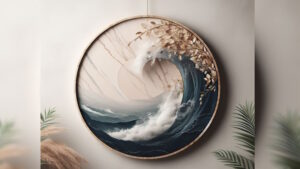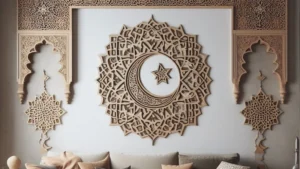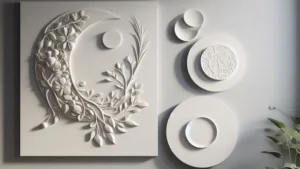Do you enjoy small living but struggling to find ways to make your blank home feel more inviting and personalized? Look no further than your walls!
Adding wall decor is a fantastic way to bring life into your home without taking up valuable floor space. However, choosing the right pieces for your limited wall real estate can be a challenge.
In this article, we’ll explore the key principles of choosing, mixing, matching, and hanging Wall Art For Small Spaces. We’ll cover everything from selecting the right size and scale to complementing colors and styles with your existing furnishings.
By the end of this Nousdecor article, you’ll have the knowledge and inspiration to transform even the tiniest of rooms such as bedroom, living room or bathrooom into an inviting oasis through thoughtfully selected interiors.
Takeaways
- When it comes to decorating small spaces, choosing the right artwork is crucial. Small rooms benefit from art pieces that complement the limited space and, at the same time, enhance the aesthetics of the area.
- Thoughtful placement and arrangement of wall art can create an illusion of space, with a focus on strategic placement that optimizes the room.
- For those looking to make the most of their wall space, engaging in DIY projects to create multi-functional art offers small space solutions. These DIY projects transform everyday items into decorative and functional pieces that serve a dual purpose.
- Wall lighting can also be considered to enhance the artwork on display, adding to the overall ambiance in small spaces.
- Additionally, efficient art storage solutions with seasonal art rotation can help maximize wall space for changing displays, ensuring that your wall art always feels fresh and exciting in your compact environment.
Wall Art For Small Spaces: Guide to Free up narrow space for Living Room & Bathroom
When living in a small apartment, it is crucial to utilize every inch of your room effectively, including your walls. Wall decor can be a great way to decorate and add personality to your wall, without taking up valuable floor space.
- When choosing art prints or pieces from your favorite artist, consider the size and scale that will best suit your bedroom or any other room in your home. Opt for smaller pieces to avoid overwhelming a smaller wall space.
- Additionally, selecting colors and styles that complement your existing décor like your bookshelf can enhance the overall design of the room.
- Mixing and matching different types of art, such as vintage pieces and modern prints, can add an eclectic touch to your room. To create a focal point in your bedroom, consider arranging a collection of decor in a vertical manner to draw the eye upward.
- Another option is to create a gallery wall, displaying multiple pieces of art in a grid or asymmetrical pattern for maximum impact.
- Lastly, when hanging your work, precision and care are essential. Use a level to ensure your pieces are straight, and use appropriate hardware to securely hang them in place.
With these ideas and design tips, you can free up much-needed room in your small apartment while also adding style and personality to your walls.
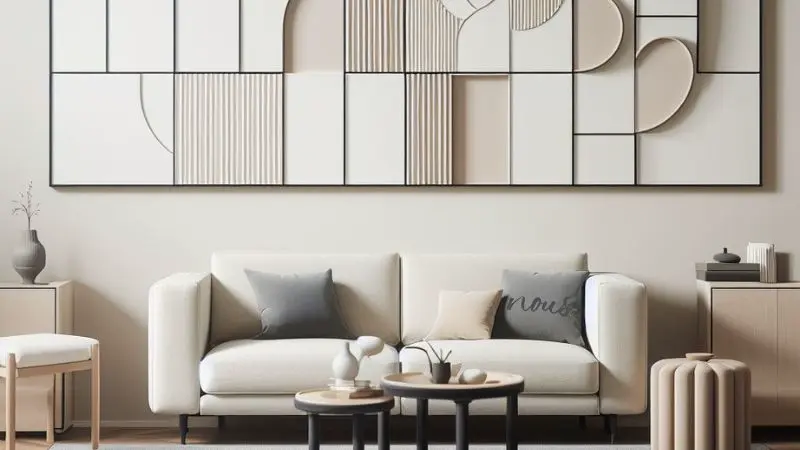
Choosing the Right Size & Scale
Picking the perfect size and scale for your decor is crucial to transforming your small bedroom design ideas into a stunning visual experience.
- To find the right size, measure the wall where you want to hang your large-scale art. Consider how much room you want to leave around the edges, as well as any furniture or architectural elements that might be nearby.
- Besides size, you can also incorporate unique materials to add texture and interest to your walls. A metal sculpture or woven tapestry can add depth and dimension without taking up too much physical space.
Keep in mind that different textures will play with light differently, which can affect how they look in different parts of the day. By considering both size and material when picking out your art, you’ll be sure to create an impactful statement that complements rather than overwhelms your wall.
Selecting Colors & Styles that Complement Your Space
When selecting colors and styles that complement your smaller room decorating ideas, think about what kind of mood you want to evoke in the room. Do you want something serene and calming? Bold and energizing? Make sure that they complement the overall atmosphere of your wall.
- As you begin selecting art, take into account any existing color schemes or patterns in the room. If you have neutral tones throughout the space, consider adding pops of color through bold artwork.
- For example, blues and greens are often associated with calmness and relaxation, while yellows and oranges bring energy and vibrancy to a room. Additionally, texture choices can also impact the mood of your space.
- On the other hand, If there are already vibrant elements in place such as patterned curtains, bright accent pillows, or decorative sconces, opt for more subdued decor that won’t overpower the room.
By considering color psychology and texture choices alongside existing design elements in the room, you’ll be able to choose pieces that enhance rather than detract from the overall aesthetic.
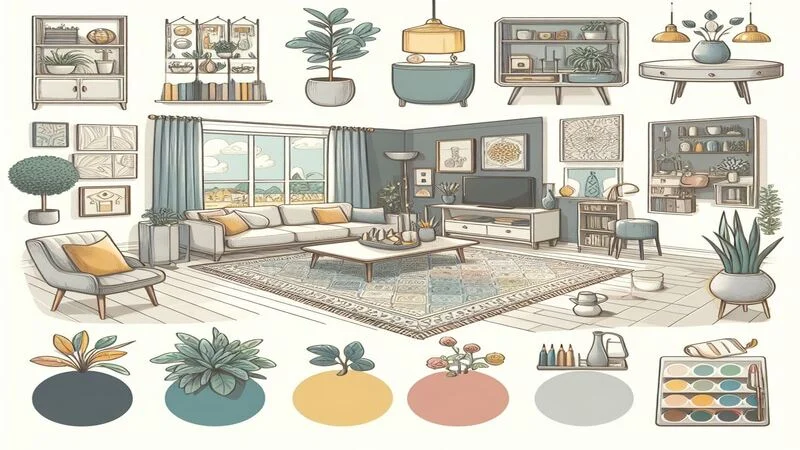
Mixing & Matching Different Types of Wall Decor
Get creative and think outside the box by mixing different types of artwork to add visual interest and personality to your living room. By doing so, you can create a dynamic display that catches the eye from every angle.
- Symmetry and asymmetry are also important considerations when mixing and matching. Symmetrical arrangements can provide a sense of balance in your room, while asymmetrical displays can add an element of surprise or whimsy. Experiment with both approaches to see what works best.
- When mixing different types of decor, it’s essential to maintain a cohesive overall look. Choose pieces that share common themes or color palettes, or use similar frames or matting to tie everything together.
With the right combination of textures, dimensions, symmetry or asymmetry, and design elements, you can create a unique display against a textured backdrop that truly reflects your personal style.
Creating a Gallery Wall for Maximum Impact
Create a striking display by combining different types of artwork on a gallery wall that tells the story of your unique style. Mixing textures, arranging layouts, and using budget-friendly options are all key factors to consider when creating a visually appealing gallery wall.
- To mix textures, try incorporating pieces made from different materials such as canvas paintings, framed photographs, metal sculptures, or macramé hangings.
- Arranging the layout can be done by starting with one larger piece in the center and building around it with smaller pieces or creating symmetry with matching frames on each side.
- Budget-friendly options include using printable art found online or repurposing thrift store finds by painting over them or framing them in an unconventional way.
Creating a gallery wall is not only an opportunity to express your personal style but also to showcase treasured memories and moments through art. By taking measurements beforehand and using proper hardware for weight distribution, you can ensure that your artwork is securely hung at eye level for maximum impact.
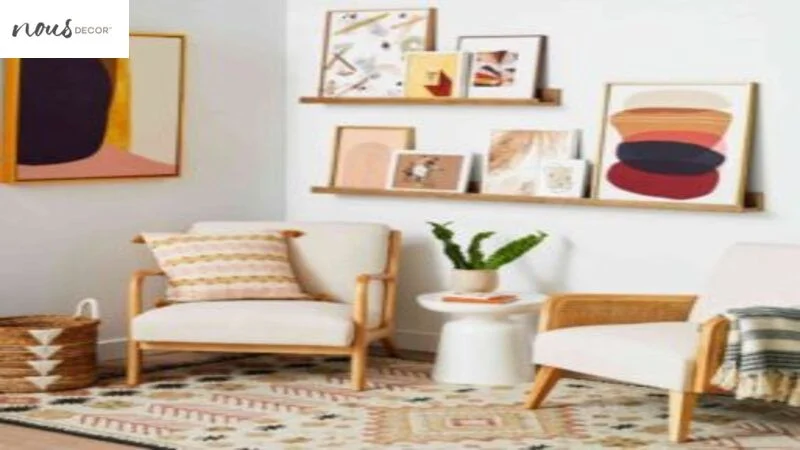
Hanging Your Artwork with Precision and Care
Hang your decor pieces with precision and care by taking proper measurements beforehand and using the right hardware for secure weight distribution,
By following these tips for precise and careful installation, you can enjoy your beautiful display in even the smallest room!
- Use measuring tools like a tape measure or ruler for accuracy ensuring your pieces are displayed at eye level for maximum impact.
- Consider the overall layout when determining placement using measuring tools like a tape measure or ruler to ensure accuracy when determining the placement of each piece.
- Choose appropriate hanging hardware based on weight/size/wall surface. The type of hardware you use will depend on the weight and size of your artwork, as well as the type of wall surface it will be hung on.
- Create a mock-up on the floor before actually hanging anything on the wall. This allows you to see how everything will look together and make any necessary adjustments before committing to a final display.
By taking these steps into account, you can rest easy knowing that it will provide an aesthetically pleasing centerpiece in your room without sacrificing safety or practicality! Remember – precision and care pay off in creating stunning displays that last for years to come!
Frequently Asked Questions
Conclusion
So there you have it – our guide to maximizing your décor with wall art in small spaces! By following these tips and tricks, you can turn your tiny room ideas into reality. Remember to choose the right size and scale for your decor, select colors and styles that complement your space, mix and match different types of art, create a gallery wall for maximum impact, and hang your work with precision and care.
But most importantly, don’t forget to have fun! Wall décor is a great way to express yourself creatively while adding personality and character to any room. So go ahead and experiment with different pieces until you find the perfect combination that truly reflects who you are. With a little creativity and some design know-how, there’s no limit to what you can achieve!

